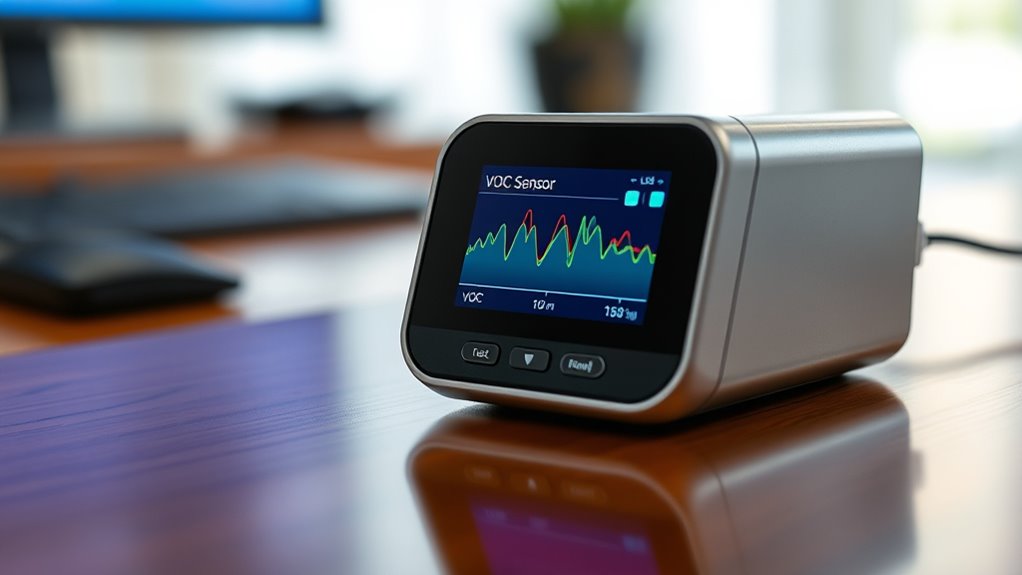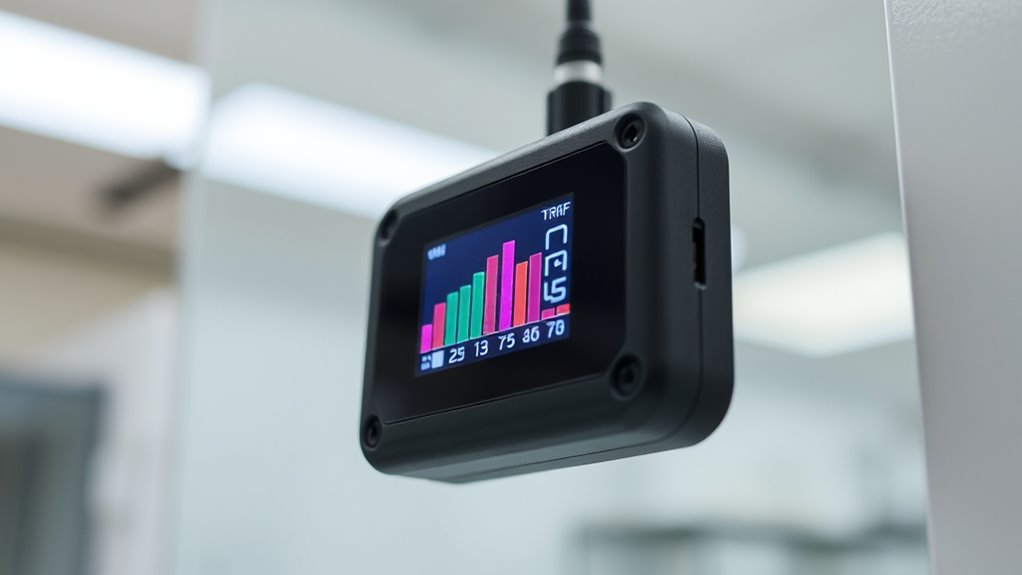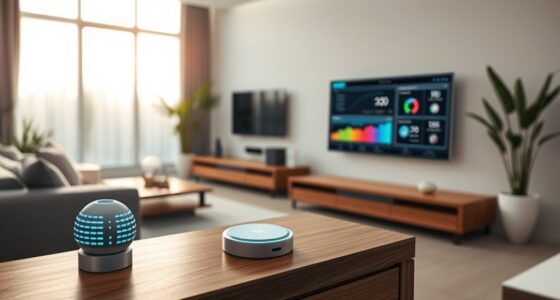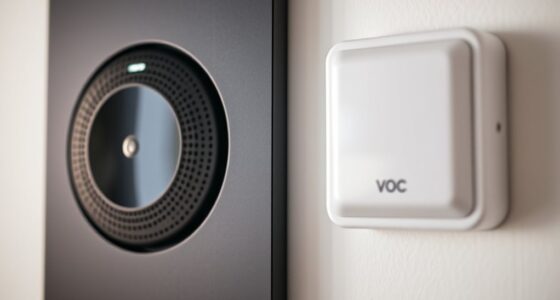To interpret VOC sensor readings, first compare them to safety thresholds and consider your environment’s specific factors like activity levels or sources such as cooking or industry. Regular calibration guarantees accuracy, while understanding baseline levels helps spot deviations that could signal poor air quality. Recognize that elevated levels may be environment-specific and require action, like ventilation. If you keep exploring, you’ll gain better insights into making informed decisions for safer, healthier indoor or outdoor spaces.
Key Takeaways
- Understand that higher VOC readings can indicate poor air quality or specific sources of pollution.
- Always compare sensor levels to manufacturer thresholds to assess safety or hazards.
- Consider environmental factors like activity, temperature, and humidity that influence VOC levels.
- Regularly calibrate your sensor to ensure accurate, reliable readings over time.
- Use VOC data alongside contextual information to decide if ventilation or mitigation is needed.

Understanding VOC sensor readings is crucial for evaluating air quality and ensuring safety in both indoor and outdoor environments. When you look at your sensor data, you’re essentially examining air quality indicators that reveal the presence and concentration of volatile organic compounds. These readings help determine whether your environment is safe or if action is necessary to reduce exposure. However, interpreting these signals accurately depends on understanding how the sensor functions and the importance of proper sensor calibration.
VOC sensors measure the concentration of organic compounds in the air, often reported in parts per billion (ppb) or parts per million (ppm). But these raw numbers don’t tell the whole story by themselves. You need to take into account the context, such as the ambient environment, activity levels, and potential sources of VOCs. For example, elevated readings in a kitchen could be due to cooking fumes, while in an industrial setting, they might indicate hazardous chemical emissions. Recognizing these air quality indicators allows you to assess whether your indoor air is within safe limits or if ventilation or other mitigation measures are needed.
VOC readings need context—consider environment, activity, and sources for accurate air quality assessment.
One common mistake beginners make is overlooking the importance of sensor calibration. Over time, sensors can drift or become less accurate, leading to unreliable readings. Regular sensor calibration ensures that the data you rely on truly reflects the actual VOC levels in your environment. Calibration involves comparing the sensor’s output against a known standard or reference and adjusting it to align with accurate measurements. Without calibration, you risk misinterpreting air quality conditions—either overestimating safety or failing to recognize a hazardous situation.
To interpret VOC sensor readings effectively, you should familiarize yourself with the typical baseline levels for your environment. Many sensors come with manufacturer-recommended thresholds or guidelines that help you determine when air quality is acceptable and when it isn’t. Keep in mind that these thresholds differ depending on the environment and the specific VOCs present. For example, what’s considered safe in a home might differ from industrial standards. By understanding these air quality indicators and maintaining proper sensor calibration, you can make informed decisions about ventilation, filtration, or evacuation. Additionally, understanding the contrast ratio of your projector can help you evaluate image quality more accurately in different viewing conditions.
Frequently Asked Questions
How Do VOC Levels Correlate With Specific Indoor Pollutants?
VOC levels often correlate with specific indoor pollutants, as they originate from common VOC sources like paints, cleaning products, and furniture. When VOC readings rise, you can suspect increased levels of pollutants such as formaldehyde or benzene. Understanding this pollutant correlation helps you identify sources and improve indoor air quality. Keep in mind that different VOCs may have unique signatures, so monitoring helps you target specific VOC sources effectively.
Can VOC Sensor Readings Be Affected by Temperature or Humidity?
You might wonder if temperature or humidity could skew your VOC sensor readings. The answer is yes—environmental factors can influence accuracy, causing fluctuations. That’s why regular sensor calibration is essential; it helps account for these variables. So, keep an eye on environmental conditions, and calibrate your sensor often to guarantee reliable readings. This way, you stay one step ahead, uncovering the true VOC levels in your space.
What Is Considered a Safe VOC Concentration Threshold?
You should aim to keep VOC concentrations below established VOC exposure standards, which typically recommend levels under 500 parts per billion (ppb) for indoor air. Sensor sensitivity thresholds vary, but if your sensor detects levels approaching or exceeding these limits, it signals potential health risks. Regularly monitor your readings, and if they surpass safe thresholds, increase ventilation or take other measures to reduce VOC exposure and maintain a healthy environment.
How Often Should VOC Sensors Be Calibrated for Accuracy?
You might think VOC sensors need frequent calibration, but typically, sensor maintenance involves checking calibration every 6 to 12 months. To guarantee accuracy, follow the manufacturer’s recommendations, as calibration frequency depends on usage and environmental conditions. Regular calibration helps avoid false readings and maintains sensor reliability. Keep an eye on sensor performance and recalibrate if readings become inconsistent. Proper maintenance ensures your VOC sensors provide trustworthy data over time.
Are VOC Sensors Reliable for Long-Term Indoor Air Quality Monitoring?
VOC sensors can be reliable for long-term indoor air quality monitoring if you stay aware of their sensor lifespan and calibration frequency. Over time, sensors may drift, reducing accuracy, so regular calibration helps maintain reliability. You should also monitor the sensor’s lifespan, replacing it as recommended by the manufacturer. When properly maintained, VOC sensors provide consistent data, making them a valuable tool for ongoing indoor air quality management.
Conclusion
Understanding VOC sensor readings helps you identify indoor air quality issues quickly. Did you know that the EPA recommends VOC levels stay below 0.5 ppm for healthy indoor environments? By regularly monitoring these readings, you can take proactive steps to improve your air quality and protect your health. Remember, consistent awareness and action make a real difference—so keep an eye on those numbers and breathe easier every day.









